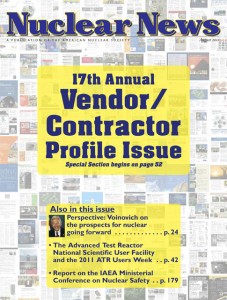Nuclear News' 17th annual vendor/contractor issue
The August issue of Nuclear News is available in hard copy and electronically for American Nuclear Society members (click here-log-in required).
 The issue contains a 122-page special section containing advertisements and "advertorial" information about products and services provided by various companies serving the nuclear industry.
The issue contains a 122-page special section containing advertisements and "advertorial" information about products and services provided by various companies serving the nuclear industry.
In addition, the August issue contains the following feature articles:
- The Advanced Test Reactor National Scientific User Facility
- 2011 ATR Users Week-Meeting the Needs of the Nuclear Community
- A report on the International Atomic Energy Agency's Ministerial Conference on Nuclear Safety
- A perspective by former Sen. George Voinovich on enabling nuclear energy and the prospects for new nuclear
Additional news items of note in the August issue: Appeals court rejects lawsuit to stop the Department of Energy from ending the Yucca Mountain project, but leaves the door open; Xcel Energy and the federal government settle on used fuel lawsuits; tests show that commercial off-the-shelf computer components can withstand the space environment; the Interior Secretary withdraws 1 million acres of federal land near the Grand Canyon from new uranium mining claims; universities and national laboratories to collaborate on nuclear security; the Domestic Nuclear Detection Office tests new technology at Belmont Stakes; major concrete repair extends Crystal River-3's outage to 2014; the Nuclear Regulatory Commission approves license renewal for Prairie Island and Salem-1 and -2; poll shows that residents living near nuclear plants continue to favor nuclear power; the Jordan Atomic Energy Commission receives three bids to build first nuclear power plant; referendum ends plans to reintroduce nuclear power in Italy; and much more.
Past issues of Nuclear News are available here.
This post first appeared on the ANS Nuclear Cafe.










